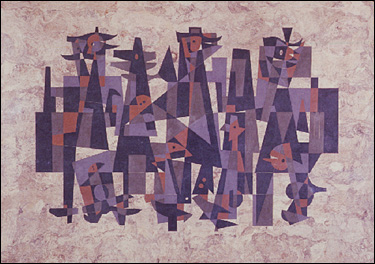
Los tres reyes(The Three Kings) is a fine example of Mérida’s fusion of cubist-inspired style with American sources. Amatl paper, used for popular paintings throughout central and southern Mexico, provides a lively textural support for flat planes of color.
Los tres reyes, 1965. Carlos Mérida (Guatemalan). Acrylic on bark/leaf paper: 28" x 39". Gift of Mrs. George Brown.
In 1919 Mérida moved to Mexico, where he found greater support for his indigenous and folkloric interests. He was a technical assistant on Diego Rivera’s first mural at the National Preparatory School in Mexico City (1922-23) and was later commissioned to do murals himself. His interest in abstract art, however, caused him to drift away from the social realist muralists.
A highly accomplished technician and designer, Mérida also illustrated books on Mayan myth and folklore and designed theater sets and furniture. A firm proponent of “the integration of the arts,” Merida allied painting, sculpture, and architecture in his work on the Benito Juárez Housing Project in Mexico City (1952). He created a glass mosaic mural, The Confluence of Civilizations, for HemisFair 1968 at the Convention Center in San Antonio, Texas.
Mérida’s unique style is both subtle and sophisticated. His free-floating, dancing shapes suggest ancient Indian as well as contemporary influences and interests.